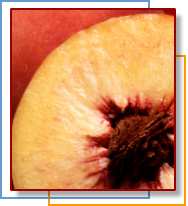
The peach is a member of the rose family. It was first cultivated in
China and revered as a symbol of longevity. The image was placed on
pottery and received as a gift with great esteem. Travelers along caravan
routes carried the peach seed to Persia before it was cultivated in
Europe. In the early 1600s Spanish explorers brought it to the New World
and by the 1700s missionaries had established peaches in California.
| |
| Peaches |
Serving
Size 1 medium peach (98g)
|
Amounts
Per Serving |
% Daily
Value |
| Calories |
40 |
| Calories
from Fat 0 |
|
| Total Fat 0g |
0% |
|
Saturated Fat 0g |
0% |
| Cholesterol
0mg |
0% |
| Sodium 0mg |
0% |
| Total
Carbohydrate 9g |
3% |
|
Dietary Fiber 2g |
7% |
|
Sugars 9g |
|
| Protein 1g |
|
| Vitamin A |
6% |
| Vitamin C |
10% |
| Calcium |
0% |
| Iron |
2% |
* Percent Daily Values are based on a
2,000 calorie diet. |
|
| |
|
Peaches are available almost all year. The season dictates the variety.
Semi-freestones (Queencrest) are early season late April to June. In
mid-June the market shifts to freestone (Elegant Lady) or clingstone. On
the off seasons peaches are imported into the U.S. from Chile and Mexico.
Fresh varieties are sold as freestone while clingstone is usually used for
canning. The fruit inside these peaches is either yellow or white. The
white flesh is a "sub-acid" fruit its flavor is more sugary
sweet. The more traditional color is yellow. It's more acidic, which does
give it a bit more flavor. Half of the United States crop comes from the
South and the other half from California. The United States also produces
25% of the total world market (THE PACKER 1999).
When selecting fresh peaches, look for ones that are soft to the touch,
blemish free, and have a fragrant smell. Peaches that are mildly fragrant
ripen into sweet and delicious flavors. Choose fruit that has a background
color of yellow or cream and has a fresh looking appearance. Peaches may
have some red "blush" depending on the variety, but this isn’t
a sign of how the fruit will taste after it’s ripened. At home peaches
can be ripened at room temperature in a brown paper bag in 2 to 3 days.
Peaches are highly perishable, so don't buy more than you plan to use.
When selecting can peaches, choose those labeled "packed in it's own
juice" and "no added sugar"; these are the healthier
choices.
The best way to ripen stone fruit is to place the fruit in a paper bag,
fold the top of the bag over loosely, and place the bag on the counter for
one to three days. Never store hard fruit in the refrigerator, in plastic
bags, or in direct sunlight.
Check the fruit daily. When it is ripe, it will be aromatic and will give
slightly to gentle pressure. Once ripened, it can be stored in the
refrigerator for about a week.
Wash peaches carefully in cool soapy water, then rinse well before
eating or using. Unless a recipe calls for it, you never need to peel the
fruits; in fact, many of the nutrients found in stone fruits are contained
in the peel, and it’s highly recommended that the peel be consumed along
with the flesh. If used in cooking they peel really fast if blanched in
boiling water for a minute then plunged into ice water to cool. In fruit
salads or platters, sprinkle cut peaches with lemon juice to help them
keep their great color.
Recipes
Pan-seared Chilean Sea Bass with Summerwhite Peach Salsa
Makes 4 servings.
 Ingredients Ingredients
2 cups (1 lb) fresh, ripe Summerwhite California peaches, pitted and
sliced
¼ cup minced scallions
½ cup cilantro, chopped
jalapeno chilis, seeded, deveined and minced (to taste)
superfine sugar (to taste)
salt and pepper (to taste)
¼ cup fresh lime juice
½ t five-spice powder
2 Tbsp. safflower oil
4 (1½ lbs) Chilean sea bass steaks, 6 oz each, skinned and boned
cilantro sprigs (for garnish)
lime wedges (for garnish)
Salsa: Combine diced peaches, scallions, cilantro, chilis, sugar, salt
and pepper in a small bowl. Mix well. Set aside for at least one hour at
room temperature or overnight in the refrigerator. Mix in lime juice
before serving.
Fish: Preheat oven to 350 degrees. Mix five-spice powder with oil and
brush onto both sides of steaks. Heat large sautè pan over high heat
until it begins to smoke. Sear sea bass until golden brown on both sides. Finish
cooking to desired doneness in the oven.
To serve, place one steak on each of the four plates. Divide salsa evenly
and spoon over and along side. Garnish with cilantro sprigs and lime
wedges.
Nutrition analysis per serving: Calories 330 (35% from fat); Fat 14g
(sat 2g); Protein 42g; Carbohydrates 15g; Fiber 2g; Cholesterol 136mg;
Sodium 129mg.
Find more in our
recipe database!
|



